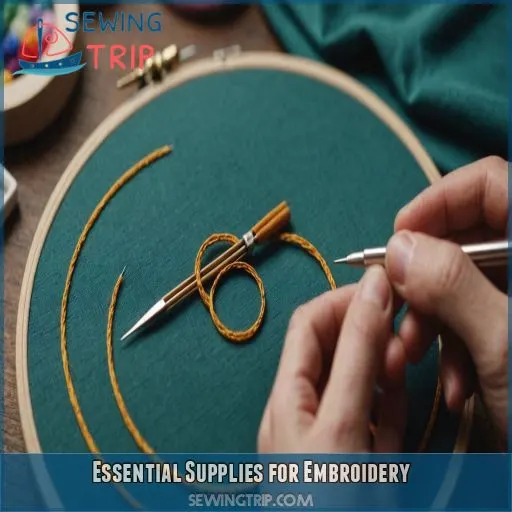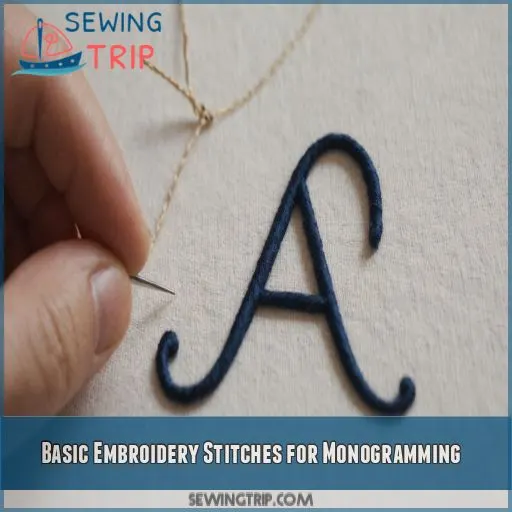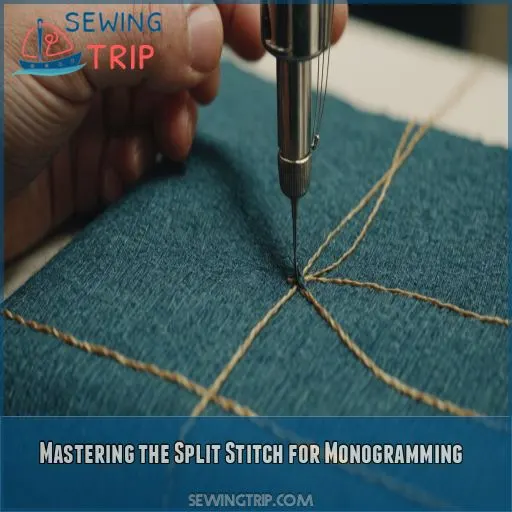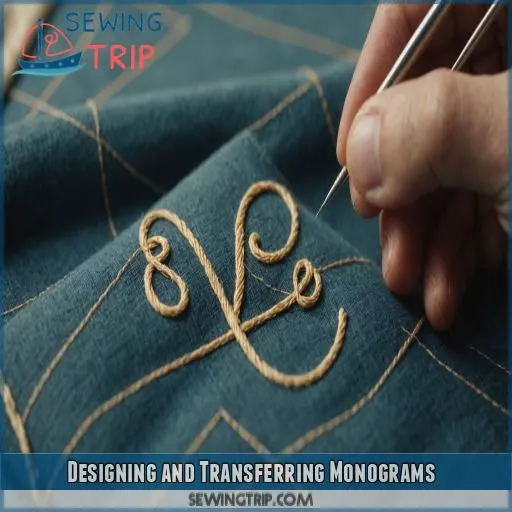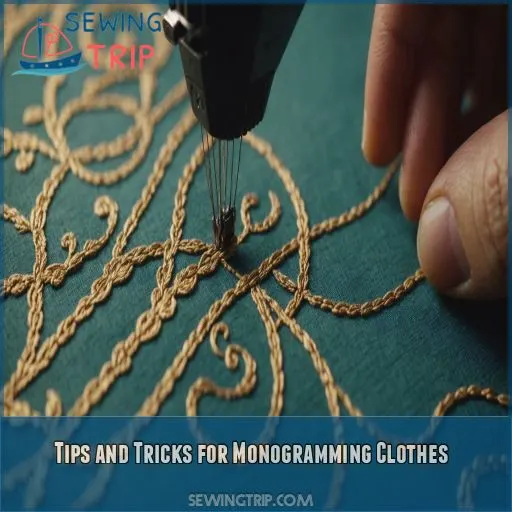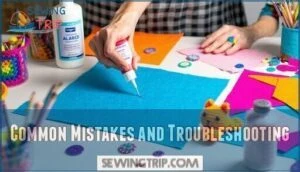This site is supported by our readers. We may earn a commission, at no cost to you, if you purchase through links.
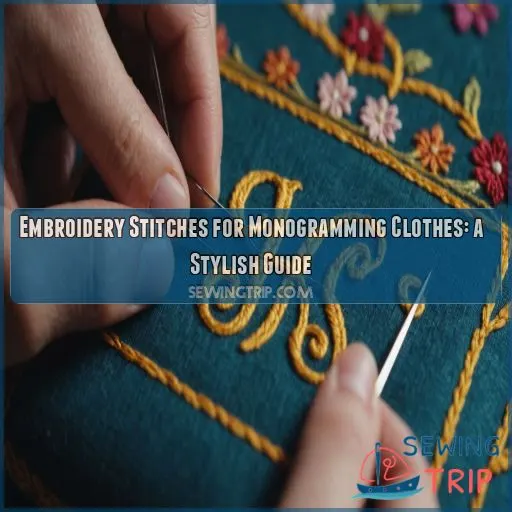
The running stitch is your go-to for straightforward designs, while the back stitch provides those solid, crisp outlines.
For defining your letters, the split stitch is your faithful companion, ensuring smooth lines.
Don’t forget the fishbone stitch for adding leafy flair.
Table Of Contents
Key Takeaways
- Monogramming with embroidery stitches is like having a magical toolbox at your fingertips. You’ve got the running stitch for simple designs and the back stitch for crisp lettering. The split stitch is your trusty sidekick for smooth lines, while the fishbone stitch adds leafy flair. Dive into this creative dance and watch your initials pop!
- Picking the right needle is like choosing a perfect dance partner; it makes all the difference! Smaller needles are great for delicate fabrics, sharp ones for thicker materials, and embroidery-specific needles for those intricate stitches. Think of it like picking the right shoes for the dance floor—comfort and style are key.
- Designing monograms is an artful adventure! Start with choosing the right font—it’s as important as picking the perfect outfit. Use tracing paper and a light box for accuracy in transferring your designs, because even superheroes need their trusty gadgets to succeed.
- Every stitch is a step in your creative journey, so embrace the quirks and celebrate the handmade charm! Mistakes add character, like a quirky plot twist in your favorite story. Practicing on scrap fabrics helps you experiment, refine your style, and create monogrammed masterpieces with confidence and flair.
Essential Supplies for Embroidery
Starting your embroidery journey is like setting off on a colorful adventure, where the right supplies are your trustworthy companions. From hoops that keep your fabric in place to threads that add vibrant personality, you’ll need these essentials to stitch your way to monogramming magic!
Embroidery Hoops and Their Importance
Avoid discussing things which would be discussed in the NEXT SUBTOPIC entitled "Embroidery Thread and Floss Options".
OUTPUT ONLY THE PROCESSED TEXT, WITHOUT ANY ADDITIONAL COMMENTARY.
Choosing the Right Embroidery Needle
Choosing the right embroidery needle is like picking the perfect dance partner—essential for a smooth experience. Consider these tips to match your needle to the job:
- Use smaller needle sizes for delicate fabrics.
- Choose sharp needles for thick fabrics.
- Match needle type to thread thickness.
- Opt for embroidery-specific needles for intricate stitches.
Embroidery Thread and Floss Options
You’ve nailed down the needle choice, but what about the colorful threads that bring your monograms to life? Embroidery thread and floss come in various types, thicknesses, and colors. Aim for durable options with a pleasing sheen. Whether you’re tackling satin stitches or basic embroidery stitches, picking the right thread makes monogramming clothes a real joy!
Scissors and Other Miscellaneous Tools
Now that you’ve chosen your embroidery floss, it’s time to grab your scissors. A sharp pair keeps your threads tidy, preventing tangles that mimic your messy teenage closet. Keep an embroidery hoop handy to maintain that flawless tension. Don’t forget a needle threader, or you’ll spend eternity squinting! Fabric markers help your design pop like fireworks.
Basic Embroidery Stitches for Monogramming
Mastering the basic embroidery stitches essential embroidery stitches is the key to monogramming clothes like a pro.
learn basic embroidery stitches.
. From the classic running stitch to the elegant split stitch, these techniques will have your personalized designs looking absolutely fabulous in no time!
Running Stitch for Simple Designs
Running stitch, the buttered toast of embroidery, makes monogramming clothes a breeze. Perfect for beginners, it’s adaptable across fabric types, handling even stretchy materials with grace. Play with stitch length to suit your design—shorter for detail, longer for bold forms. Thread thickness can alter texture, adding flair and depth to your project. It’s simple, yet powerful!
Back Stitch for Creating Solid Lines
You’ve mastered the running stitch—now, let’s explore the back stitch, your go-to for solid lines and crisp lettering in embroidery!
- Thread Magic: Keep your stitch tension tight to avoid floppy lines.
- Border Wizardry: Use this stitch for borders that stand out.
- Thickness Trick: Vary thread strands to achieve different thicknesses.
Embroidery is all about creativity!
Split Stitch for Monogramming Letters
Starting an embroidery project? The split stitch is your trusty sidekick for monogramming clothes! Imagine this: each stitch like a tiny bridge, splitting and connecting threads with split stitch variations that suit your chosen monogramming fonts. Keep an eye on thread tension and stitch consistency to fill letters beautifully. Your DIY embroidery will look sharp and seamless!
Fishbone Stitch for Leafy Designs
Once you’ve mastered the split stitch for your monogram’s letter, it’s time to add some flair with the fishbone stitch.
This versatile stitch creates lovely leafy designs that can be stitched in a variety of colors and patterns.
Play with different shades of green to achieve a natural, gradient effect, or layer multiple fishbone stitches for a more intricate, textured look.
The fishbone stitch is a game-changer for elevating your monogrammed clothing.
Mastering the Split Stitch for Monogramming
Mastering the split stitch to monogram your clothes is like discovering a secret talent for transforming fabric into art. You’ll learn how to create a seamless line that stitches up your style, one little poke at a timejust be careful not to poke yourself more than the cloth!
Creating a Simple Straight Stitch
Creating a simple straight stitch is easier than pie. Thread your needle and start on the fabric’s underside. Gently pull it through, ensuring even tension to avoid puckering in your favorite monograms. Aim for uniform stitch length—think of it as sewing whispers, not shouts. Ready to add a dash of creativity? You’re halfway to mastering embroidery!
Bringing the Needle Back Through the Fabric
You’ve got your straight stitch ready; now, it’s time to work some magic. Bring the needle back through the fabric, gently! It’ll feel like threading a needle through a whisper—light and careful.
- Needle direction matters! Keep it smooth and steady.
- Mind your stitch tension for a clean look.
- Consider fabric thickness—adjust your thread choice!
Splitting the First Stitch in Half
Once you’ve made that initial straight stitch, it’s time to split it in half. Carefully bring your needle back through the fabric, right through the center of that first stitch. This split-stitch technique is the key to creating those smooth, defined lines that are perfect for monogramming. Take your time and focus on maintaining even tension – you’ve got this!
Creating a Continuous Line of Split Stitches
You’ve got the hang of split stitching, now keep that rhythm going! Here’s how to create a consistent and continuous line:
- Maintain even stitch length for professional flair.
- Ensure stitch tension control—nobody likes a saggy stitch!
- Choose the right thread for smoother flow.
- Look at needle size; bigger isn’t always better here.
And voilà, stitching perfection!
Designing and Transferring Monograms
Creating beautiful monograms starts with picking the right font, ensuring your designs reflect personal style and elegance without the risk of looking like your grandma’s tea towels. Use tracing paper and a light box to transfer your design onto fabric, it’s like copying homework but way more fun and artistic transferring embroidery designs.
!
Choosing the Right Font and Lettering Style
Ah, fonts! They’re your secret weapon. Deciding between serif or sans serif font styles can feel like picking a winning lottery ticket. Monogram fonts should reflect your style; script fonts add elegance, while handwritten fonts scream creativity. Test them out, imagining each as the flair on a superhero cape. Trust your instincts, and watch your design soar!
Using Tracing Paper to Create a Design
A simple piece of tracing paper can be your secret weapon for creating stunning monogram designs.
Just sketch out your vision, cut it to size, and pin it right onto the fabric.
No need for fancy transfer methods – this foolproof technique makes sure your design lands exactly where you want it.
Get creative with different paper thicknesses and doodle all your dream monograms!
Transferring the Design to the Fabric
Before you start, grab your tracing paper and gently position it on your fabric. Make sure the design’s perfectly placed. Use light pencil pressure to trace—too hard, and you’ll leave frustrating marks! Different fabric types might need a gentler touch, so keep that in mind. Getting the tracing right is the first step to a fabulous embroidered masterpiece!
Using a Light Box for Accurate Transfers
For the precise art of transferring monogram designs, a light box works wonders! Hover your tracing paper over the fabric like an overhead projector. Choose from various light box types, or DIY with a window and natural daylight. No need for magic—just place, trace, and voilà! This bright strategy livens up even the most finicky embroidery project.
Tips and Tricks for Monogramming Clothes
Monogramming clothes can be a creative adventure where your personal style shines, even if your stitches aren’t textbook perfect. By trying out different fonts and colors, adding fun embellishments, and practicing on scraps, you’ll make each piece uniquely yours while giving yourself permission to laugh at those charming little mishaps.
Experimenting With Different Fonts and Colors
Experiment with a variety of font pairings and color palettes to make your monogram truly one-of-a-kind. Try pairing a bold, modern letter with delicate floral accents or a classic script with vibrant thread colors. The possibilities are endless! Get creative and have fun exploring different monogram styles that reflect your personal style.
- Mix bold and delicate fonts
- Coordinate thread colors with your design
- Experiment with classic and contemporary monogram styles
- Let your personality shine through in your monogram
Adding Embellishments for Extra Flair
Spice up your monogrammed clothes with a sprinkle of personality! Adding embellishments like beads, sequins, or even charms can transform a simple stitch into a showstopper. Imagine your needle as a wizard’s wand, waving magic with ribbons or bright yarn. Just remember, it’s not about perfection—it’s about capturing your unique charm and flair!
Practicing on Scrap Fabric Before Starting
- Color Matching: Test your colors and see how they play together.
- Design Testing: Experiment with different designs.
- Beginner Tips: Practice those stitches until they’re second nature!
Embracing Imperfections and Celebrating the Handmade
Imagine this: you’re monogramming, and a stitch goes rogueembrace it! Those quirky imperfections add hand-stitched charm, giving your project its unique character. Every uneven loop is a nod to the DIY spirit and handmade value. It’s like touching the stars through thick clouds; the beauty lies in their imperfect allure. Celebrate these little hiccupsthey make your creation uniquely yours!
Common Mistakes and Troubleshooting
Embroidering your dream monogram doesn’t have to be a nightmare! Learn how to avoid common pitfalls like discrepancies in design transfer, a warbly letter, and messy design lines. With a few simple tricks, you’ll be stitching up stylish monograms like a pro in no time.
Avoiding Discrepancies in Design Transfer
Transferring a design onto fabric shouldn’t feel like threading a needle in the dark. With a trusty light box, you can improve tracing accuracy, even on tricky fabrics that stretch like yoga pants in a sale. Consider the grid method for design scaling; it’s like a GPS for your monogram, guiding each line perfectly into place.
Preventing a Warbly, Wobbly Look
To sidestep the warbly, wobbly look, keep embroidery tension tight as a drum. Here’s your recipe for success:
- Hoop Tightness: Make sure your fabric’s snug in the hoop to avoid shifting.
- Stitch Consistency: Make sure stitches are even, like peas in a pod.
- Needle Size and Fabric Choice: Match needle to fabric; thick needles for heavy, thin for light.
Happy stitching!
Covering Design Lines for a Clean Finish
When aiming for a polished finish, picture your needle as a paintbrush sketching on fabric. Make sure design transfer accuracy by carefully covering lines. Stitch placement matters, so follow those outlines like a reliable GPS. Mind stitch tension, don’t let it resemble a wobbly seesaw. Your thread choice dances hand-in-hand with your fabric type, ensuring your design shines.
Leaving Space for Filling in Letters and Designs
When embroidering a monogram, be sure to leave ample space around the letter for the decorative elements.
This allows you to stitch the letter first, then fill in the surrounding design without crowding the composition.
Thoughtful placement and order of stitching will ensure a polished, cohesive look.
Don’t be afraid to experiment with different color combinations to make your monogram truly shine.
Frequently Asked Questions (FAQs)
What is the best embroidery stitch for monograms?
Did you know that over 80% of embroidery enthusiasts prefer split stitch for monograms? It’s the Goldilocks stitch—not too tight, not too loose, just right for creating crisp lines while feeling like a creative embroidery wizard!
What embroidery stitch for lettering?
For embroidering words onto clothing, the split stitch is your new best friend! This simple yet effective stitch creates a clean, polished line that’ll make your custom designs pop. Trust me, you’ve got this!
How to monogram initials on fabric?
Monogramming initials on fabric is a delightful dance of needle and thread. Start by tracing your design, mount it in a hoop, then use split or stem stitch for a clean finish. Embrace mistakes—it’s handmade!
What is the difference between embroidery and monogramming?
Embroidery‘s like painting with thread, creating detailed designs on fabric. Monogramming’s a specialty within embroidery, focusing on initials or symbols. It’s like personalizing a gift, adding that extra sprinkle of class and uniqueness to your clothes!
How to choose thread colors for monogramming?
Think of thread colors like a painter choosing a palette—let your personality shine through! Match your monogram colors with the fabric’s hues, or contrast boldly for flair. This choice is your canvas, so paint it joyfully!
What fabric types are best for monogramming?
For monogramming, choose sturdy fabrics like cotton, linen, or denim. Just like a solid canvas for a masterpiece, these fabrics provide the perfect blend of durability and smoothness, ensuring your stitches shine brilliantly.
How do embroidery hoop sizes affect monogramming?
Imagine squeezing a big dog into a tiny sweater—it won’t fit right. Similarly, choosing the wrong hoop size can distort or warp your monogram. Opt for a snug fit to keep monograms neat and avoid puckering.
What are the best tools to transfer designs?
When transferring designs, grab a light box for precision tracing or go old-school with carbon transfer paper. Both methods are like your trusty sidekicks, ensuring your monogram lands perfectly on that dreamy fabric canvas!
How do tension settings impact stitched monograms?
Don’t fret over tension settings—you’ve got this! Tight tension might pucker your monogram, while loose tension can look sloppy. Imagine tension as your dance partner: too tight, and you’ll trip; too loose, and you’ll stumble. Find balance!
Conclusion
Picture your clothes adorned with personal flair—how thrilling is that?
With these embroidery stitches for monogramming clothes, you can transform plain fabric into a canvas of creativity.
Whether you’re stitching a heartfelt gift or personalizing your wardrobe, you’ve got the tools and techniques to make your monograms stand out.
Embrace each stitch, laugh at the inevitable tangles, and celebrate your unique touch.
Keep exploring, and let your imagination run wild with delightful, embroidered designs!

